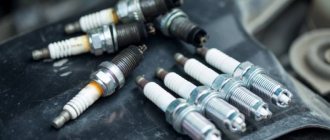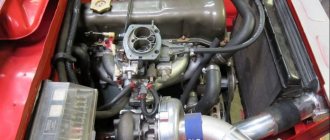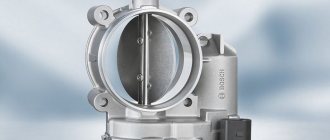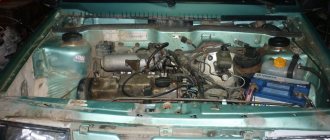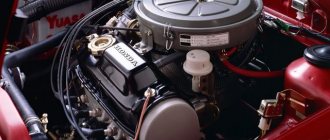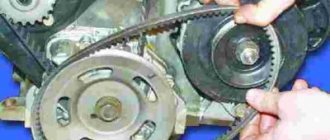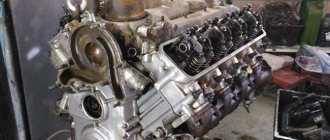VAZ 2109 injection engine
The VAZ 2109 injection engine is not new. Since 1994, such units have been installed on cars of the Lada family. As you know, there have always been supporters and opponents of both carburetor and injection options. On the VAZ 2109, injection engine starting means less harmful emissions into the environment, better dynamics at high speeds and much more. From this publication you will learn not only the difference between both types of engine, but also receive valuable tips on how to change a carburetor unit to an injection unit with your own hands. So, both units have more than enough advantages. Before choosing which engine to choose for your “nine”, it is recommended to decide in what mode the car is operated most of the time. All this is of considerable importance.
Carburetor engine for VAZ 2109
VAZ 2109 injection engines
What can I say? Until now, many people respect this type of engine, despite its obsolescence. As you know, such engines are not installed on production cars today, but there are quite a few examples on the roads with a carburetor unit.
Note. Carburetor versions of engines have long received a scolding in developed countries. In Europe, where ecology and clean air are of great importance, such engines have long been blacklisted.
In principle, the large emission of harmful substances into the atmosphere is the first and most important disadvantage of such engines. Other features of this motor include the following:
- At high speeds, the “carburetor” significantly reduces its capabilities. We are talking about torque, which, however, is highest at low speeds.
Note. In particular, at high speeds it is more difficult for a VAZ 2109 with a carburetor power unit to overtake, due to the fact that the car’s throttle response is significantly reduced. On the other hand, when starting from a standstill, such an engine allows you to increase the required speed very quickly (14 or 16 s/100 km/h).
- High fuel consumption compared to an injector is another minus. As you know, the carburetor absorbs as much fuel as required. For example, under heavy loads it will require a lot of fuel (usual consumption is 8.7 l/100 km);
VAZ 2109 injection engine
- The presence of manual control of the air damper is a minus, but in the cold season it allows, as experienced motorists say, to “feel” the engine.
Note. Some VAZ 2109 models with a carburetor unit, released recently, even had automatic control of this damper.
Such an engine, of course, also has its advantages:
- First of all, the price of a carburetor is much cheaper;
- Its maintenance is also much easier and inexpensive;
- The absence of any control units on microcontrollers is considered by fans of carburetor VAZ 2109 as an advantage;
- An experienced driver can repair a carburetor anywhere, even in an open field, without special tools or an assistant.
Note. One of the options for quick carburetor repair involves purging, when two armored pipes are swapped. But with an injection engine this will definitely not be possible.
Types of injection on injection engines VAZ 21083, 21093, 21099
On injection engines of VAZ 21083, 21093, 21099 cars, several types of injection are used. This is simultaneous, pair-parallel and phased injection.
Let's consider what happens during the operation of each type of injection and determine which of them is the most “advanced” of all.
Types of injection on injection engines of VAZ 21083, 21093, 21099 cars
— Simultaneous injection
All injectors simultaneously inject fuel into the cylinders every full revolution of the engine crankshaft (360°).
Used in engine control systems with control units:
BOSCH M1.5.4 (2111-1411020)
These are VAZ 21083, 21093, 21099 cars produced before 2001 with the 2111 engine, without a neutralizer, with the ability to manually adjust CO (potentiometer), toxicity standards R-83.
January 5.1.1 (2111-1411020-71)
VAZ 21083, 21093, 21099 cars produced after 2001 with engine 2111, without a neutralizer, without a potentiometer, but with the ability to regulate CO in the exhaust gases using an externally connected technological potentiometer, toxicity standard R-83.
— Alternating (pair-parallel) synchronous double injection
Every half revolution of the crankshaft (180°), a pair of injectors fires, injecting fuel into two cylinders of the engine. The next half turn (another 180°) another pair of injectors fires.
Alternating injection with the operating order of injectors 1-4, 2-3.
Used in ECM with control units:
January 4.1 (2111-1411020-22)
VAZ 21083, 21093, 21099 cars produced before 2001 with engine 2111, without converter, with the ability to manually adjust CO (potentiometer), toxicity standards R-83 or USA-83.
GM ISFI-2S (2111-1411020-10 (20, 21))
BOSCH M1.5.4N (2111-1411020-60)
January 5.1 (2111-1411020-61)
VS 5.1 (2111-1411020-62)
VAZ 21083, 21093, 21099 cars with 2111 engines equipped with a neutralizer, oxygen sensor, gasoline vapor recovery system, EURO-2 standards.
BOSCH M1.5.4 (2111-1411020-70)
VS 5.1 (2111-1411020-72)
VAZ 21083, 21093, 21099 cars produced after 2001 with engine 2111, without a neutralizer, without a potentiometer, but with the ability to regulate CO in the exhaust gases using an externally connected technological potentiometer, toxicity standard R-83.
Alternating injection with the operating order of injectors 1-3, 2-4.
ECM with BOSCH MP7.0H unit (2111-1411020-40) .
VAZ 21083, 21093, 21099 cars with 2111 engines equipped with a neutralizer, oxygen sensor, gasoline vapor recovery system, EURO-2 standards.
— Sequential (phased) injection
The injectors fire in turn (sequentially) after each rotation of the engine crankshaft by 180° according to the order of operation of the cylinders - 1-3-4-2.
Used in electronic engine control systems with BOSCH MP7.0H units (2111-1411020-50) . These are VAZ 2108, 2109, 21099 cars with a neutralizer, two oxygen sensors, a gasoline vapor recovery system, and a phase sensor (EURO-3 toxicity standards).
Notes and additions
— Injector – a device for injecting fuel into the engine cylinders. It is an electromagnetic valve, which, having received an impulse from the control unit, injects fuel under pressure onto the intake valve plate.
Twokarburators VK - More information on the topic in our VKontakte group, on Facebook Twokarburators FS and on Odnoklassniki - Twokarburators OK
More articles on the VAZ 21083, 21093, 21099 injector
— Applicability of controllers (ECU) on VAZ 21083, 21093, 21099 vehicles
— Temperature sensor for injection engines of VAZ 21083, 21093, 21099 cars
— Speed sensor for injection engines of VAZ 21083, 21093, 21099 cars
— Operating order of the VAZ 21083, 21093, 21099 engine injection system
— Knock sensor for injection engines of VAZ 21083, 21093, 21099 cars
Injector
VAZ 2109 with injection engine
As in the case described above, there are advantages and disadvantages here. If I may say so, then all the advantages of the “carburetor” are the disadvantages of the injector and vice versa.
Peculiarities
They are as follows:
- An injection engine has lower emissions of harmful substances and is more suitable to modern requirements than a carburetor engine;
- Torque is the opposite situation with the “carburetor”. Here at low speeds there is insufficient performance, but at high speed such a motor almost gets a second wind;
- Servicing the injector will cost a little more;
- The injector must be filled with clean fuel (otherwise the injectors will clog), while almost everything that gets into the carburetor flows into the carburetor;
- Malfunctions of the injector are shown by diagnostics, for which, again, you have to pay a tidy sum;
- The injector has lower fuel consumption, especially on the highway (6-7 l/100 km). This advantage is easy to explain: the injectors on such an engine are controlled by a computer that supplies a strictly measured amount of fuel.
Advice. The amount of fuel supplied depends on the ECU firmware. And if your VAZ 2109 with an injector consumes more fuel than normal, perhaps these are errors in the software.
- There is no need to use any “suction” or anything similar when servicing an injection engine. All unit speeds will be electronically regulated;
- Today, many owners install 4th generation gas equipment on cars. It is much easier to install such a kit on a VAZ 2109 than on the version with a carburetor.
Conversion of carburetor to injector VAZ 2109
First you need to choose a good injection system for the VAZ 2109. Bosch M 1.5.4 is perfect for installation due to its reasonable cost. We installed the injection system without additional upgrades or improvements. This is better than installing an external fuel pump and purchasing additional parts from General Motors.
It is more correct to buy parts that have already been time-tested and are used on production cars, including:
Various bolts, clamps and other consumables are not a problem to purchase at any store.
Tank replacement
Before disassembling the carburetor system, wash and dry the new gas tank and install an electric fuel pump. Remember that the arrows on them must match in both places. Make sure that the float of the sensor indicating the fuel level in the gas tank.
Holes for mounting the module and sensor
Next, you need to make a hole in the cylinder block for mounting a bracket designed for an ignition module with a depth of 20 mm, and another one for the knock sensor (16 mm). To do this, drain the antifreeze and remove the radiator along with the bumper.
Cooling, generator
Among other things, you need to install a new coolant pipe, and change the temperature sensor in the radiator. After this, you need to drain the oil and remove the pan from there, remove the toothed pulley and belt, and install a special generator damping pulley instead of the standard one.
Then it is necessary to install a new generator, since the new system requires more voltage than usual. Here you can’t get by with just a regular pulley replacement. We need to install a new generator in our VAZ 2109 - this is a must. Otherwise, the generator will simply become unusable.
Wires, connecting devices
- Next, you need to roll out the gasoline - the tank should become lighter.
- Then, before proceeding with further manipulations, remove the battery.
- After this, remove the distributor and fuel pump with all accessories, air filter, carburetor and cables (gas and air supply).
If everything is done, disconnect the ignition wires. They are under the hood. We also remove the fuel pipes, switch, gas tank and vacuum booster hose, which needs to be made longer. It can be taken from one of the previous versions of the VAZ.
Also disassemble the instrument panel. There is a check engine light on it that needs to be connected to a wire. You need to bring the ignition harness out from the engine into the cabin, and connect the wires responsible for the injection harness to the wiring box.
The wires that remain from the carburetor fan relay must be short-circuited together with the fan switch sensor.
We attach all the fuses, relays and controller in the designated places. It is also important to connect the fuel pump to the dashboard. This is necessary for correct fuel level readings (we just remove the standard one).
The block has a head on the side with a plug on which you need to secure the mass of the harness responsible for fuel injection. It is also important not to forget to install the receiver and manifold, as well as the throttle pipe and fuel rail.
Installation of the fuel line
What takes the most time and effort is the fuel line, which needs to be laid along the bottom of our VAZ. It is very difficult to run the fuel line under the steering wheel. After all, secure the fuel hoses and filter. There are special bolts for the filter at the bottom of the car. Finally, replace the gas tank and connect the fuel line, and also replace the ignition, sensors and high-voltage wires in their places.
Replacing a carburetor with an injector for UAZ and Gazelle cars is slightly different. The differences are due to the characteristics of the Gazelle engine.
Converting a carburetor to an injector
VAZ 21093 injection engines
It is possible to do this. As promised, we provide instructions. The alteration can be carried out in your own garage, preferably with an assistant.
An object
The object of modification can be not only the VAZ 2109, but also the G8, as well as the VAZ 21099 (cars with carburetor engines). The goal and objective of the operation: to convert the unit into a 16-valve injector by installing a cylinder head from a VAZ 2112. Already at the stage of completing the conversion, without even adjusting the ECU, a big difference is felt. The dynamics of the car increases, the car behaves differently on the highway, and gas consumption decreases. On the other hand, the car's performance deteriorates at low speeds, but they are compensated by improved traction at high speeds (after 2000 rpm).
Note. Any owner of a “nine” will be glad that now his car will show the same acceleration in 4th speed as in the past in 3rd. If only the road is straight, then the “injector” will show itself and easily reach the level of 5000 rpm.
Preparation
The operation, of course, requires proper preparation. The following components should be, as they say, at hand:
- A cylinder head from a “two-piece”, equipped with a receiver and manifolds;
cylinder head VAZ 2112
- Special knock regulator (sensor);
- Throttle pipe with throttle position regulator;
- Mass air flow sensor and much more (a detailed list can be read or downloaded from other articles on our website).
Rework
To replace a carburetor with an injector yourself, be sure to arm yourself with the following components:
- Cylinder head from VAZ 2112 with receiver and manifolds;
- Knock sensor;
- Throttle pipe with throttle position sensor;
- Mass air flow sensor and a number of other elements.
Replacement kit
When everything is ready, you can start working.
- Remove the old cylinder head. Plus, remove all attachments in the fuel assembly, gas tank and ignition system.
- Remove the alternator, thermostat, pulleys and belts.
- Install a new gas tank with a pump, borrowed from a donor - an injection VAZ.
- Remove the carburetor and ignition system components that need to be replaced.
- Disconnect the cooling system pipes and hoses. Here, install a completely new kit from the injector.
- Remove the pan.
- Install new pistons from an injection donor and connecting rods at 10. Standard carburetor components are not designed for an injection compression ratio. Plus there are special recesses for other valves.
- Install a new unit with an underflow on the cover for the DPKV, replacing the standard oil pump. If you can remove the cover, then only that will be replaced.
- After removing the old cooling system pipes, install new ones. The best solution is to replace the entire set. Buying it won't really impact your overall budget.
- Prepare everything necessary to mount the 16 valve head. The fasteners match, only the bolts from the old head are long and need to be shortened. Plus, don’t forget to make a size 12 hole in the new head.
- Install new fuel lines from the donor.
- Connect your new gas tank to the lines.
- Route the wiring from the control unit to the fuel pump. You can use old fuel level regulators from a carburetor car.
- Cut a hole in the wall of the engine compartment through which the wiring will be routed. This way you won't have to make the standard wires longer.
- Install the knock sensor by drilling a hole in the block and tapping a size 8 thread.
- Be sure to replace the water pump using a unit from donor 2112.
- Get a new crankcase breather and oil dipstick. Install them instead of the previous ones.
- Install a new cylinder head. Just don't forget to change the gasket, which corresponds to a different head.
- Install a thermostat borrowed from a VAZ 2112.
- Connect the coolant pipes.
- Remove the rear timing cover and rollers. The pulleys from 2112 are dismantled. The belt must be installed in accordance with the marks.
- Install the new generator along with the drive. For the new generator, the upper fasteners will remain intact, since they are not provided for by the design of the carburetor VAZ 2109. Therefore, fasten the pair of lower mounting bolts as securely as possible.
- Place all the sensors in their new places.
- Seal the valve covers with a good quality sealant.
- Assemble the ignition module, wires, spark plugs and other components.
- Install the air filter.
- Get your exhaust system back to normal. The muffler is often left stock, but the resonator and other components are taken from the donor.
- The wiring is connected to the dashboard and the lock.
- Fill in new oil, refuel the car with high-quality fuel.
- Start the engine and take it for a test drive.
What you can get
By converting the carburetor into an injection car, you can get improved technical and dynamic characteristics. We offer you a comparison of the parameters of the two motors.
| Characteristic | Carburetor | Injector |
| Cylinder diameter | 76 millimeters | 82 millimeters |
| Engine power | 64 kW | 78 kW |
| Fuel consumption in the city and on the highway | 9/8.7 liters per 100 km | 9.5/7 liters per 100 km |
| Acceleration from 0 to 100 km/h | 16 seconds | 13 seconds |
| Maximum speed | 148 km/h | 155 km/h |
Converting a carburetor to an injector is a serious step in modernizing your VAZ 2109. Despite the apparent complexity, the process can be done even with your own hands. But only if you have sufficient experience.
Loading …
